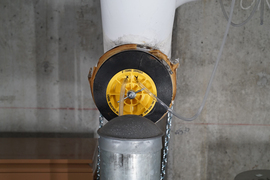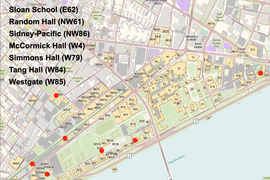This week, MIT began piloting a wastewater testing program as a new tool to help keep the campus community safe this semester. In a project that will run through the fall semester, wastewater from seven buildings on campus will be tested each day for SARS-CoV-2, the virus that causes Covid-19.
The project is designed to determine if wastewater testing can be an effective early warning system for Covid-19 outbreaks on campus, and is being evaluated as a complementary tool in the Institute’s response to the pandemic, along with clinical testing, contact tracing, and other measures.
Results of the wastewater testing will be communicated to MIT’s Covid Monitoring Team, a cross-Institute collaboration that looks at health trends on campus and makes recommendations to the Covid Decision Team, which is made up of MIT’s senior leadership, to determine next steps. Buildings will not be quarantined on the basis of the test results, but people in the buildings where the virus is detected may be asked to get tested at MIT Medical sooner than otherwise scheduled. The project team members stress that the sampling data is aggregate and cannot be used to identify individuals.
“We view the wastewater treatment data as a part of [the larger portfolio of data] that goes to the Covid Decision Team that helps make strategic choices about campus operations,” MIT Medical Chief of Staff Brian Schuetz says. “It gives us interesting insight into populations, which is really what we’re focused on. [Responding to Covid-19] is a population health initiative, and this fits into that.”
Wastewater testing offers complementary advantages to clinical testing because it reflects health at the community level, is not limited by clinical testing availability, and sheds light on both symptomatic and asymptomatic infections. The lab of biological engineering Professor Eric Alm, which has been testing municipal wastewater for Covid-19 around the country since March, has shown that at the population level, wastewater data precede clinical observations of Covid-19 by four or more days.
“It makes a lot of sense when you think about the fact that there’s a lag between the time somebody gets sick and starts shedding the virus, and the time when they’re symptomatic enough to seek care and get a clinical test,” says Katya Moniz, a research scientist in the Alm Lab.
Wastewater testing is already being used at a number of colleges across the country. In one case, at the University of Arizona, wastewater testing helped detect an outbreak among asymptomatic individuals and officials were able to take precautionary measures before the virus spread.
At MIT, the following buildings have been selected for sewage testing during the pilot:
· MIT Sloan School of Management (E62)
· Random Hall (NW61)
· Sidney-Pacific (NW86)
· McCormick Hall (W4)
· Simmons Hall (W79)
· Tang Hall (W84)
· Westgate (W85)
Sampling ports installed on the sewage exit lines of each building will extract a small amount of wastewater from the pipes every two minutes. A subsample of that wastewater will be tested each day by the Alm Lab. The test results will then be sent to MIT’s Covid Monitoring Team.
“The goal of this pilot is to build this infrastructure for a subset of buildings on campus and use that data to decide if this is an effective method of monitoring Covid-19 outbreaks on campus,” says Moniz.
The wastewater-based testing project team has met with the faculty, student, and staff leaders of the buildings where the initiative is being piloted, explaining how wastewater-based testing monitors pathogens and guides interventions. The team members also explained that they will only be testing for Covid, and that detection will be aggregate — it will not identify individuals.
The program, which has been approved by the Legal, Ethical, Equity Committee for MIT Campus Planning, is part of a collaboration between MIT Facilities, the Environment, Health, and Safety Office, Housing and Residential Services, and the Alm Lab.
For more information, contact wb-pilot@mit.edu.















